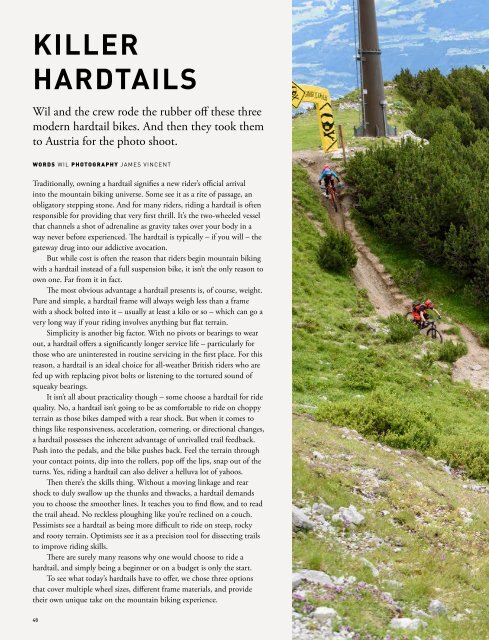Singletrack
Create successful ePaper yourself
Turn your PDF publications into a flip-book with our unique Google optimized e-Paper software.
KILLER<br />
HARDTAILS<br />
Wil and the crew rode the rubber off these three<br />
modern hardtail bikes. And then they took them<br />
to Austria for the photo shoot.<br />
WORDS WIL PHOTOGRAPHY JAMES VINCENT<br />
Traditionally, owning a hardtail signifies a new rider’s official arrival<br />
into the mountain biking universe. Some see it as a rite of passage, an<br />
obligatory stepping stone. And for many riders, riding a hardtail is often<br />
responsible for providing that very first thrill. It’s the two-wheeled vessel<br />
that channels a shot of adrenaline as gravity takes over your body in a<br />
way never before experienced. The hardtail is typically – if you will – the<br />
gateway drug into our addictive avocation.<br />
But while cost is often the reason that riders begin mountain biking<br />
with a hardtail instead of a full suspension bike, it isn’t the only reason to<br />
own one. Far from it in fact.<br />
The most obvious advantage a hardtail presents is, of course, weight.<br />
Pure and simple, a hardtail frame will always weigh less than a frame<br />
with a shock bolted into it – usually at least a kilo or so – which can go a<br />
very long way if your riding involves anything but flat terrain.<br />
Simplicity is another big factor. With no pivots or bearings to wear<br />
out, a hardtail offers a significantly longer service life – particularly for<br />
those who are uninterested in routine servicing in the first place. For this<br />
reason, a hardtail is an ideal choice for all-weather British riders who are<br />
fed up with replacing pivot bolts or listening to the tortured sound of<br />
squeaky bearings.<br />
It isn’t all about practicality though – some choose a hardtail for ride<br />
quality. No, a hardtail isn’t going to be as comfortable to ride on choppy<br />
terrain as those bikes damped with a rear shock. But when it comes to<br />
things like responsiveness, acceleration, cornering, or directional changes,<br />
a hardtail possesses the inherent advantage of unrivalled trail feedback.<br />
Push into the pedals, and the bike pushes back. Feel the terrain through<br />
your contact points, dip into the rollers, pop off the lips, snap out of the<br />
turns. Yes, riding a hardtail can also deliver a helluva lot of yahoos.<br />
Then there’s the skills thing. Without a moving linkage and rear<br />
shock to duly swallow up the thunks and thwacks, a hardtail demands<br />
you to choose the smoother lines. It teaches you to find flow, and to read<br />
the trail ahead. No reckless ploughing like you’re reclined on a couch.<br />
Pessimists see a hardtail as being more difficult to ride on steep, rocky<br />
and rooty terrain. Optimists see it as a precision tool for dissecting trails<br />
to improve riding skills.<br />
There are surely many reasons why one would choose to ride a<br />
hardtail, and simply being a beginner or on a budget is only the start.<br />
To see what today’s hardtails have to offer, we chose three options<br />
that cover multiple wheel sizes, different frame materials, and provide<br />
their own unique take on the mountain biking experience.<br />
48






